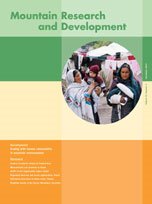Land Use Changes in Tropical Watersheds: Evidence, Causes and Remedies, edited by I. Coxhead and G.E. Shively. Wallingford, United Kingdom: CABI, 2005. xi + 191 pp. £49.50, US$90. ISBN 0-85199-912-3.
The highlands of the tropics are changing rapidly. Since 1900, a huge expansion in temperate vegetable production has occurred, driven partly by international demands of large supermarket chains and partly by the increasing availability of refrigerators in the rapidly-growing tropical cities and changes in shopping habits and diet among the expanding tropical middle classes. From Peru to Kenya and the Philippines, tropical highland slopes have been cleared to provide new areas for beans, lettuces, and similar crops. Often, these clearances lead to severe erosion. They always lead to great changes in family organization and agricultural practices. In many areas—especially areas with road access—traditional shifting cultivation has been abandoned, and fields are cultivated continuously, instead of being left fallow for periods of 3 to 8 years.
The drivers behind these processes of change are economic, the most important being access to new markets and new opportunities to earn cash incomes. The uplands are becoming more tightly linked to the remainder of the country, and government policies for lowland agriculture have repercussions in the uplands. This book explores the impacts of these factors through an analysis that focuses on the Manapuli watershed in northern Mindanao in the Philippines and examines biophysical evidence of degradation in the watershed, economic and institutional factors, and potential remedies. The research was conducted in a participatory manner together with the local community from 1992 to 2004. The authors point out that a host of community-based watershed management programs have been carried out in South East Asia since 1980, funded by a variety of aid agencies and not always learning lessons from each other. The book contains some important lessons that ought to be picked up by others working to improve the management of tropical uplands.
The authors recognize the need for interdisciplinary approaches, particularly those that combine economics, soil science, hydrology, sociology and anthropology. Perhaps they should have considered the idea of Integrated River Basin Management more fully. Alternatively they might consider the “human ecology of watersheds” as an appropriate term. However, there is also a need to examine the political ecology of these upland management systems, closely analyzing the overlapping roles of the institutions involved.
The local context of upland environmental change in the Manapuli watershed was large-scale deforestation by loggers extracting timber, followed by agricultural activity. Between 1974 and 1994, primary forest cover was reduced from half to less than one-third of the local land area, being replaced by maize-based farming systems. Migrants, including some from northern Luzon, acquired land from indigenous people, and ownership claims were made through officially invalid means such as land tax declarations. After 1994, forest clearance slowed, but agricultural intensification continued to be driven by opportunities in domestic and international markets. Water quality monitoring showed that sediment losses from gentler, but intensively-used lower slopes were often higher than from steep slopes. Although sediment concentrations were measured during high flows, the monitoring procedures did not enable accurate calculations to derive mean annual sediment yields that could be compared with those found elsewhere in South East Asia. However, the participatory community water quality data collection was successful and provided a good opportunity to help the community understand the environmental impact of agricultural practices. Some good modeling work, although based on the USDA WEPP model rather than the approach developed by Calvin Rose and his team for South East Asia (eg Ciesolka et al 1995), reinforced the high rate of soil loss in the lower parts of the watershed where agriculture is most intense.
In terms of reducing soil loss, the authors recommend growing of trees and crops in an intercropping system: “As long as economic incentives exist for the cultivation of high value vegetable and maize crops in tropical highlands, the promotion of intercropping between trees and annual crops and the development of better land management practices under perennial/annual crop cropping systems will be essential to enhance the long-term sustainability of such farming systems in the Philippines and elsewhere.” Simulation of the impacts of changes in land management showed that restrictions on vegetable growing would reduce farm incomes by about 15% over 10 years, but would reduce downstream sediment loads by up to 37%. Soil conservation methods would be more effective but would require a government subsidy of about 390 pesos/ha/year. Payment for environmental services was also examined as a possible solution. However, there are problems of designing such a system around poor, small-scale farmers.
Overall, the book takes a predominantly economic approach, using general models of farmer behavior. It does not look in detail at how individual farmers behave. In neighboring Sabah, for example, attitudes to the land and its management often vary greatly among farmers in the same valley, depending as much on individual family circumstances as on the size of their land holding. As in so much work on watersheds and agriculture, the development of an integrated approach where all the necessary disciplinary backgrounds are represented at an approximately equal level has proved difficult. This book contains a good example of how to work within a community to examine the environmental consequences of upland agriculture and to look at the financial and policy instruments that might be employed to alleviate the problem. However, it does not really bring out how the farmers themselves actually think about these problems, and it fails to discover how they make their individual decisions.
Perhaps all expatriate researchers engaging with South East Asian rural resource problems are hidebound by their national educational and institutional backgrounds and experience of working methods. More and more we need South East Asian or ASEAN institutions to bring the expertise together and to really share experiences in a major way. This book is another step in improving our understanding and ought to be read by anyone interested in tropical upland watershed management.





